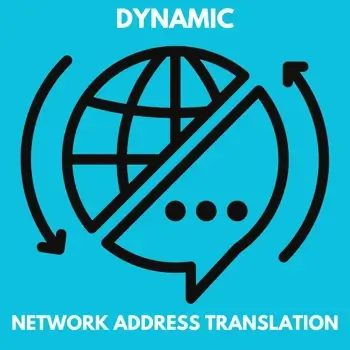What Is Dynamic NAT? Configuring Dynamic NAT
In networking, IP addresses are like digital passports that allow devices to connect to the Internet. However, the pool of available public IP addresses is limited. This is where dynamic NAT becomes essential. By dynamically mapping private IP addresses to a pool of public IP addresses, NAT enables multiple devices to share a limited number of public addresses.
In this article, learn the base concepts of dynamic NAT, including its working principles, benefits, and applications.
What is dynamic NAT?
Dynamic NAT, or dynamic network address translation, is a type of NAT that maps private IP addresses to public IP addresses from a pool of available public IPs. In networking, the method assigns a public IP address to a device on the local network when it needs to access the Internet.
Each internal device can select a public IP from a group of public IP addresses. Once the session ends, this public IP returns to the pool for reuse. Dynamic NAT assigns public IP addresses on a first-come, first-served basis. The dynamic allocation process optimizes the use of limited public IP addresses.
One key point about dynamic NAT is that it bridges communication between private or internal networks and the Internet. Many hosts within a private network can share a smaller number of public IP addresses.
Initially, Internet authorities designed NAT as a temporary solution to this issue. The idea was to allow private networks to use non-routable IP addresses (e.g., 192.168.x.x) internally while accessing external networks using a smaller pool of public IP addresses.
As the Internet grew, so did the demand for more efficient ways to manage IP addresses. The earlier version, static NAT, offered one-to-one mapping, which was inefficient for larger organizations.
Dynamic NAT works better in most real-life scenarios, such as where private devices within a local network need to access external networks.

How does dynamic NAT work?
Imagine the following scenario: You have a private internal network (e.g., 192.168.1.x) with several devices that need to access the Internet.
The router has a pool of public IP addresses (e.g., 203.0.113.1 to 203.0.113.10).
When a device from the internal network sends a request to access the Internet, the router dynamically assigns one of the available public IPs from the pool.
Here's how the process works.
- The private network creates the initial request. When a device inside the private network initiates a connection to an external network such as the Internet, the request goes to the NAT-enabled router.
- IP mapping occurs. The router checks if the device received a public IP address. If not, it dynamically assigns one from a pool of available public IP addresses.
- Port number assignment. The router assigns a unique port number for each internal device's connection to ensure that multiple internal devices can share the same public IP. This occurs through Port Address Translation (PAT), where different port numbers distinguish between devices.
- A connection is established. The router then forwards the request to the Internet using the assigned public IP and port number, allowing external servers to respond.
- Reverse mapping. When the external server replies, the router translates the public IP and port back to the original private IP address and port, ensuring the correct device receives the response.
- The device receives a temporary assignment. The mapping of private IPs to public IPs remains only for the duration of the session. Once the session ends, the public IP returns to the pool for reuse.
Dynamic NAT often operates in environments with limited public IP addresses, enabling efficient Internet access for many devices.
Differences between static NAT and dynamic NAT
Static and dynamic NAT are both methods of network address translation, but they operate differently in how they map internal IP addresses to external ones.
In static NAT, each internal private IP address permanently maps to a specific external public IP address. This one-to-one mapping does not change.
This method often works when internal devices, like servers, need to remain consistently reachable from the external network, such as the Internet, with a fixed IP.
For example, if an internal web server needs to be accessible from the Internet, it would always be assigned the same public IP.
Dynamic NAT uses a pool of public IP addresses, and internal private IP addresses map to any available public IP address in that pool on a first-come, first-served basis.
The mapping between internal and external IP addresses can change depending on availability.
For example, a device using dynamic NAT might get a different public IP address each time it communicates externally, depending on which addresses are available in the pool.
Benefits of using dynamic NAT
Dynamic NAT provides several key benefits in network management, particularly for large networks with limited public IP addresses.
- Efficient IP address utilization. Dynamic NAT allows multiple devices to share a limited pool of public IP addresses. This optimizes IP address usage, especially when dealing with a limited number of public IPs, which benefits large networks.
- Increased network security. The technique improves security by hiding internal IP addresses. External networks can only see the public IP assigned by NAT, making it harder for attackers to target specific devices within the private network.
- Cost-effective. Instead of purchasing a public IP address for every device, dynamic NAT gives organizations the ability to use fewer public IPs while accommodating numerous internal devices.
- Scalability. It is scalable, meaning dynamic NAT can handle large networks with numerous devices. Since public IPs are assigned dynamically, more devices can connect to the Internet without each needing a unique public IP.
- Load balancing. Dynamic NAT helps balance the network load. The outgoing traffic distributes across multiple public IP addresses, thus reducing the risk of overloading a single IP address.
- Ease of administration. Since dynamic NAT automatically assigns public IP addresses from a pool, network administrators don’t have to manually configure each device's translation rules. This makes management simpler in large networks with many devices.
Limitations of dynamic NAT
While there are many benefits to this type of network address translation, there are also limitations.
- Limited public IP pool. Dynamic NAT relies on a pool of public IP addresses. If the number of internal devices exceeds the available public IPs, some devices will be unable to access external networks.
- Temporary mapping. IP address mappings are temporary, meaning devices may receive different public IPs each time they connect. This lack of consistency can cause issues with certain applications that rely on a fixed IP address.
- No port translation. Unlike PAT (Port Address Translation), dynamic NAT does not map multiple devices to a single public IP using different ports. Each device needs its own public IP, limiting the number of devices that can connect concurrently.
- Session tracking. Managing and tracking multiple sessions can be complex, particularly in large networks, as dynamic NAT requires continuous monitoring of active IP address translations.
- Scalability issues. As the number of internal devices grows, the available public IP addresses may not be sufficient, leading to failed connections.
Applications of dynamic NAT
Dynamic NAT plays a vital role in today's digital landscape, improving network efficiency and security across various applications. It works for a wide variety of tasks, from connecting home Internet to providing VPN services and hiding IPs from external networks.
A few common applications of dynamic NAT include:
- Home Internet connections. Dynamic network address translation allows multiple devices in a home network to access the Internet using a single public IP address. Users can conserve the limited pool of public IP addresses and enables seamless Internet connectivity for all household devices.
- Cloud computing. Dynamic NAT is crucial in cloud infrastructures, where it facilitates secure communication between virtual machines (VMs) and the Internet. It dynamically assigns public IPs to VMs when needed, allowing for cost-effective and scalable cloud services.
- VPN services. A virtual private network masks internal IP addresses from external networks for anonymous browsing experience. Dynamic NAT lets VPN users assign public IP addresses to users' devices when they connect.
- Corporate networks. In business environments, it enables secure Internet access for employees across large organizations. It assigns public IPs to internal devices dynamically, ensuring efficient use of available IPs without compromising network security.
- Gaming consoles. Gaming networks use dynamic NAT to allow multiple players to connect to online services using a shared IP address, ensuring smooth gameplay without exposing individual devices.
- Mobile networks. Mobile carriers utilize dynamic NAT to assign temporary public IP addresses to mobile devices during Internet sessions. It aims to efficiently management IPs with millions of devices connecting simultaneously.
Common problems with dynamic NAT configurations
While it offers numerous benefits, dynamic NAT isn’t without challenges. Here are some common issues and their solutions.
Incorrect NAT pool configuration
Sometimes, the NAT pool might be too small or misconfigured, leading to failures in address translation.
To solve this issue, ensure the NAT pool contains enough public IP addresses to serve all internal devices that require translation. Use the command to verify the NAT pool configuration.
Access control list (ACL) issues
ACLs are used to specify which traffic is translated might be incorrectly defined, leading to misrouting or blocked traffic.
To solve this issue, verify ACL configurations to ensure they permit the correct traffic to be translated. Make sure they match the internal subnets needing NAT.
Exhaustion of public IPs
If all available public IPs are used, new connections cannot be established.
To solve this issue, expand the NAT pool by adding more public IP addresses or use Port Address Translation (PAT) to allow multiple internal devices to share a single public IP.
General routing issues
Devices may fail to connect because routes to the translated public addresses are missing or misconfigured.
To solve this issue, verify routing tables on routers and firewalls to ensure correct routes are established between internal and external networks.
NAT timeout settings are misconfigured
Short NAT timeout settings can result in connections being dropped prematurely, particularly for long-lasting sessions.
To solve this issue, increase the NAT timeout settings for specific protocols or services that require longer sessions.
Frequently asked questions
Can I use dynamic NAT with IPv6 networks?
You cannot use dynamic NAT with IPv6 networks because IPv6 was designed to eliminate the need for NAT. The new version already provides sufficient address space.
What is the difference between dynamic NAT and PAT?
Dynamic NAT uses a pool of public IPs for translation, while PAT allows multiple devices to share a single public IP using different port numbers.
What happens if the public IP pool is exhausted in dynamic NAT?
If the pool is exhausted, new requests will be denied until a public IP becomes available again.
Can dynamic NAT support multiple users?
Yes, dynamic NAT can support multiple users at once. To achieve this, it allocates different public IP addresses from the pool to different devices as they connect to the Internet.

